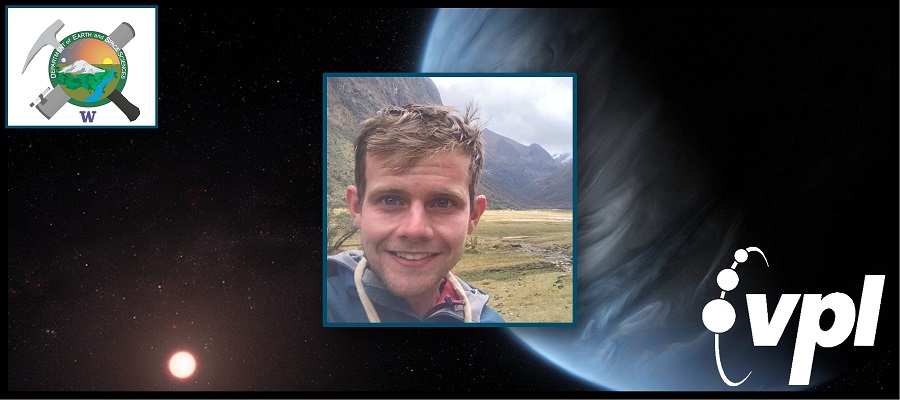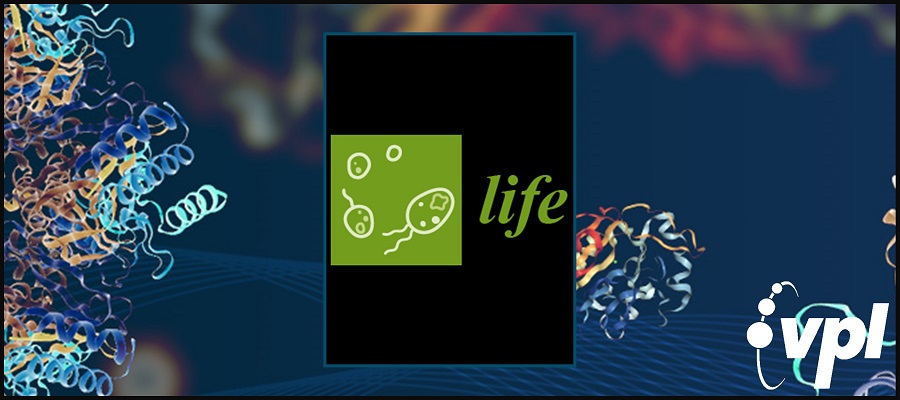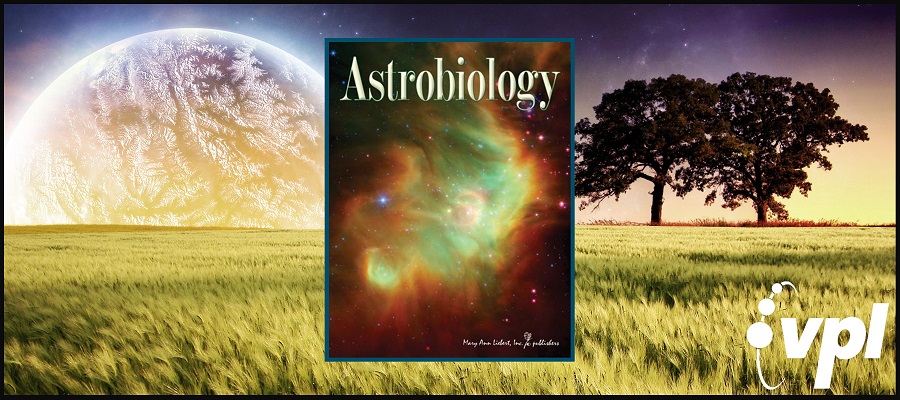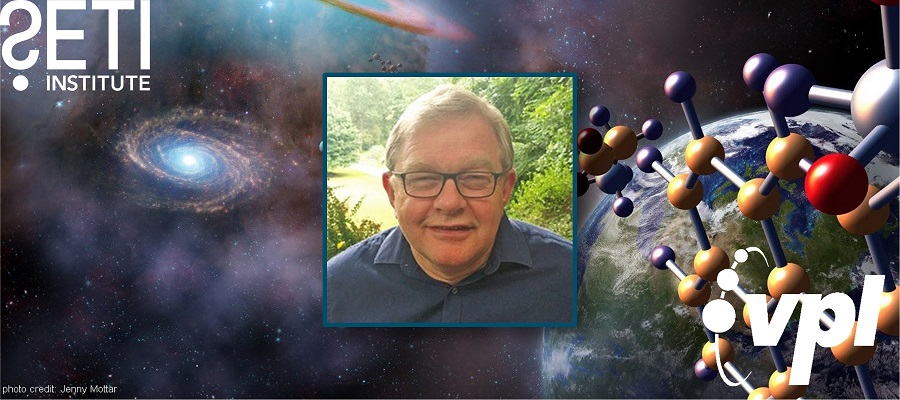VPL Postdoctoral Researcher, Andrew Lincowski (University of Washington), and VPL project PI, Victoria Meadows (University of Washington), published two new…
The observation of a 266.94 GHz feature in the Venus spectrum has been attributed to phosphine (PH3) in the Venus clouds, suggesting unexpected geological, chemical, or even biological processes. Since both PH3 and sulfur dioxide (SO2) are spectrally active near 266.94 GHz, the contribution to this line from SO2 must be determined before it can be attributed, in whole or part, to PH3. An undetected SO2 reference line, interpreted as an unexpectedly low SO2 abundance, suggested that the 266.94 GHz feature could be attributed primarily to PH3. However, the low SO2 and the inference that PH3 was in the cloud deck posed an apparent contradiction. Here we use a radiative transfer model to analyze the PH3 discovery, and explore the detectability of different vertical distributions of PH3 and SO2. We find that the 266.94 GHz line does not originate in the clouds, but above 80 km in the Venus mesosphere. This level of line formation is inconsistent with chemical modeling that assumes generation of PH3 in the Venus clouds. Given the extremely short chemical lifetime of PH3 in the Venus mesosphere, an implausibly high source flux would be needed to maintain the observed value of 20 ± 10 ppb. We find that typical Venus SO2 vertical distributions and abundances fit the JCMT 266.94 GHz feature, and the resulting SO2 reference line at 267.54 GHz would have remained undetectable in the ALMA data due to line dilution. We conclude that nominal mesospheric SO2 is a more plausible explanation for the JCMT and ALMA data than PH3.
The UCR-based Alternative Earth’s Team has received a five-year funding award from the Interdisciplinary Consortium for Astrobiology Research (ICAR). VPL…
VPL graduate student Nick Wogan (University of Washington), researcher and former student Dr. Josh Krissansen-Totton (University of California, Santa Cruz)…
VPL Researcher, David Catling (University of Washington), was recently interviewed in a Nature News article discussing NASA’s Perseverance Rover and…
Metal compounds abundant on Early Earth are thought to play an important role in the origins of life. Certain iron-sulfur minerals for example, are proposed to have served as primitive metalloenzyme cofactors due to their ability to catalyze organic synthesis processes and facilitate electron transfer reactions. An inherent difficulty with studying the catalytic potential of many metal compounds is the wide range of data and parameters to consider when searching for individual minerals and ligands of interest. Detecting mineral-ligand pairs that are structurally analogous enables more relevant selections of data to study, since structural affinity is a key indicator of comparable catalytic function. However, current structure-oriented approaches tend to be subjective and localized, and do not quantify observations or compare them with other potential targets. Here, we present a mathematical approach that compares structural similarities between various minerals and ligands using molecular similarity metrics. We use an iterative substructure search in the crystal lattice, paired with benchmark structural similarity methods. This structural comparison may be considered as a first stage in a more advanced analysis tool that will include a range of chemical and physical factors when computing mineral-ligand similarity. This approach will seek relationships between the mineral and enzyme worlds, with applications to the origins of life, ecology, catalysis, and astrobiology.
VPL Scientist Dr. Melissa Trainer (NASA GSFC) was recently featured on the Ask an Astrobiologist program! You can watch a…
Chirality is considered a universal, agnostic biosignature that is independent of a planet’s biochemistry. Researchers have recently characterized the chiral…
Photosynthesis is an ancient metabolic process that began on early Earth and offers plentiful energy to organisms that can utilize it such that that they achieve global significance. The potential exists for similar processes to operate on habitable exoplanets and result in observable biosignatures. Before the advent of oxygenic photosynthesis, the most primitive phototrophs, anoxygenic phototrophs, dominated surface environments on the planet. Here, we characterize surface polarization biosignatures associated with a diverse sample of anoxygenic phototrophs and cyanobacteria, examining both pure cultures and microbial communities from the natural environment. Polarimetry is a tool that can be used to measure the chiral signature of biomolecules. Chirality is considered a universal, agnostic biosignature that is independent of a planet’s biochemistry, receiving considerable interest as a target biosignature for life-detection missions. In contrast to preliminary indications from earlier work, we show that there is a diversity of distinctive circular polarization signatures, including the magnitude of the polarization, associated with the variety of chiral photosynthetic pigments and pigment complexes of anoxygenic and oxygenic phototrophs. We also show that the apparent death and release of pigments from one of the phototrophs is accompanied by an elevation of the reflectance polarization signal by an order of magnitude, which may be significant for remotely detectable environmental signatures. This work and others suggest that circular polarization signals up to ∼1% may occur, significantly stronger than previously anticipated circular polarization levels. We conclude that global surface polarization biosignatures may arise from anoxygenic and oxygenic phototrophs, which have dominated nearly 80% of the history of our rocky, inhabited planet.
Here we investigate whether magmatic volcanic outgassing on terrestrial planets can produce atmospheric CH4 and CO2 with a thermodynamic model. Our model suggests that volcanoes are unlikely to produce CH4 fluxes comparable to biological fluxes. Improbable cases where volcanoes produce biological amounts of CH4 also produce ample carbon monoxide. We show, using a photochemical model, that high abiotic CH4 abundances produced by volcanoes would be accompanied by high CO abundances, which could be a detectable false-positive diagnostic. Overall, when considering known mechanisms for generating abiotic CH4 on terrestrial planets, we conclude that observations of atmospheric CH4 with CO2 are difficult to explain without the presence of biology when the CH4 abundance implies a surface flux comparable to modern Earth’s biological CH4 flux
Nitrogen is an essential element to life and exerts a strong control on global biological productivity. The rise and spread of nitrogen-utilizing microbial metabolisms profoundly shaped the biosphere on the early Earth. Here we reconciled gene and species trees to identify birth and horizontal gene transfer events for key nitrogen-cycling genes, dated with a time-calibrated tree of life, in order to examine the timing of the proliferation of these metabolisms across the tree of life. Our results provide new insights into the evolution of the early nitrogen cycle that expand on geochemical reconstructions. We observed widespread horizontal gene transfer of molybdenum-based nitrogenase back to the Archean, minor horizontal transfer of genes for nitrate reduction in the Archean, and an increase in the proliferation of genes metabolizing nitrite around the time of the Mesoproterozoic (∼1.5 Ga).
Are we alone in the universe? How did life arise on our planet? How do we search for life beyond…
William Sparks recently had a proposal, titled: “Detecting the Fundamental Chiral Building Blocks of Life”, selected by the NASA Exobiology…
A vast diversity of environments exists within and beyond Earth. To the extent life depends on and interacts materially with its environment, it can be expected that life-hosting potential among these environments varies as much as the physical and chemical properties that define them. To understand this potential demands that we first understand lifes requirements in some detail. Discussion of these requirements is frequently undertaken in considering habitability. Cockell et al. (2016) argue that the term habitability is inherently binary: An environment either can or cannot sustain life. This is an important starting point in evaluating the life-hosting potential of…
Are we alone in the universe? How did life arise on our planet? How do we search for life beyond Earth? These profound questions excite and intrigue broad cross sections of science and society. Answering these questions is the province of the emerging, strongly interdisciplinary field of astrobiology. Life is inextricably tied to the formation, chemistry, and evolution of its host world, and multidisciplinary studies of solar system worlds can provide key insights into processes that govern planetary habitability, informing the search for life in our solar system and beyond. Planetary Astrobiology brings together current knowledge across astronomy, biology, geology, physics, chemistry, and related fields, and considers the synergies between studies of solar systems and exoplanets to identify the path needed to advance the exploration of these profound questions.
Planetary Astrobiology represents the combined efforts of more than seventy-five international experts consolidated into twenty chapters and provides an accessible, interdisciplinary gateway for new students and seasoned researchers who wish to learn more about this expanding field. Readers are brought to the frontiers of knowledge in astrobiology via results from the exploration of our own solar system and exoplanetary systems. The overarching goal of Planetary Astrobiology is to enhance and broaden the development of an interdisciplinary approach across the astrobiology, planetary science, and exoplanet communities, enabling a new era of comparative planetology that encompasses conditions and processes for the emergence, evolution, and detection of life.
Full Citation: Meadows V. S., Arney G. N., Des Marais D. J., and Schmidt B. E. (2020). Preface. In Planetary…
Our capacity to search for life on other worlds is rapidly advancing, both within our solar system and beyond. In the last few decades robotic missions have explored every major target of astrobiological interest in our solar system, collecting data relevant to assessing habitability across diverse environments, from rocky planets to icy satellites. Outside our solar system, we have now identified thousands of worlds orbiting other stars, many of which may be habitable, suggesting there are many places beyond our solar system where life could, at least in principle, emerge and persist. The next challenge in advancing the search for…
The development of astrobiology, the study of life in the universe, is intimately tied to the development of spaceflight in the mid to late twentieth century, which enabled the discovery and exploration of non-Earth environments that might harbor life. In 1976, the Viking missions to Mars supported a core goal to search for signs of life beyond Earth (Klein et al., 1972). However, the Viking life detection experiments provided inconclusive evidence of organics and life (e.g., Klein, 1979; Biemann, 1979; Quinn et al., 2013), a result that put a damper on both Mars exploration and exobiology (as astrobiology was known…
Liquid water oceans are at the center of our search for life on exoplanets because water is a strict requirement for life as we know it. However, oceans are dynamic habitats—and some oceans may be better hosts for life than others. In Earth’s ocean, circulation transports essential nutrients such as phosphate and is a first-order control on the distribution and productivity of life. Of particular importance is upward flow from the dark depths of the ocean in response to wind-driven divergence in surface layers.
We propose that the building blocks of RNA (nucleobases and ribose) bound to self-assembled prebiotic membranes. We have previously demonstrated that the bases bind to membranes composed of a prebiotic fatty acid, but evidence for the binding of sugars has remained a technical challenge. Here, we used pulsed-field gradient NMR spectroscopy to demonstrate that ribose and other sugars bind to membranes of decanoic acid. Moreover, the binding of some bases is strongly enhanced when they are linked to ribose to form a nucleoside or – with the addition of phosphate – a nucleotide. This enhanced binding could have played a role in the molecular evolution leading to the production of RNA.
To evaluate the influence of selection on gene content variation in hydrothermal vent microbial populations, we examined 22 metagenome-assembled genomes (MAGs) (70 to 97% complete) from the ubiquitous vent Epsilonbacteraeota genus Sulfurovum that were recovered from two deep-sea hydrothermal vent regions, Axial Seamount in the northeastern Pacific Ocean (13 MAGs) and the Mid-Cayman Rise in the Caribbean Sea (9 MAGs). Genes involved in housekeeping functions were highly conserved across Sulfurovum lineages. However, genes involved in environment-specific functions, and in particular phosphate regulation, were found mostly in Sulfurovum genomes from the Mid-Cayman Rise in the low-phosphate Atlantic Ocean environment, suggesting that nutrient limitation is an important selective pressure for these bacteria.
Several universal genomic traits affect trade-offs in the capacity, cost, and efficiency of the biochemical information processing that underpins metabolism and reproduction. We analyzed the role of these traits in mediating the responses of a planktonic microbial community to nutrient enrichment in an oligotrophic, phosphorus-deficient pond in Cuatro Ciénegas, Mexico. This is one of the first whole-ecosystem experiments to involve replicated metagenomic assessment. Mean bacterial genome size, GC content, total number of tRNA genes, total number of rRNA genes, and codon usage bias in ribosomal protein sequences were all higher in the fertilized treatment, as predicted on the basis of the assumption that oligotrophy favors lower information-processing costs whereas copiotrophy favors higher processing rates. Contrasting changes in trait variances also suggested differences between traits in mediating assembly under copiotrophic versus oligotrophic conditions. Trade-offs in information-processing traits are apparently sufficiently pronounced to play a role in community assembly because the major components of metabolisminformation, energy, and nutrient requirementsare fine-tuned to an organisms growth and trophic strategy.
he Gaia hypothesis postulates that life regulates its environment to be favorable for its own survival. Most planets experience numerous perturbations throughout their lifetimes such as asteroid impacts, volcanism, and the evolution of their host star’s luminosity. For the Gaia hypothesis to be viable, life must be able to keep the conditions of its host planet habitable, even in the face of these challenges. ExoGaia, a model created to investigate the Gaia hypothesis, has been previously used to demonstrate that a randomly mutating biosphere is in some cases capable of maintaining planetary habitability. However, those model scenarios assumed that all non-biological planetary parameters were static, neglecting the inevitable perturbations that real planets would experience. To see how life responds to climate perturbations to its host planet, we created three climate perturbations in ExoGaia: one rapid cooling of a planet and two heating events, one rapid and one gradual.
VPL co-investigator David Catling (UW) and collaborator Jonathan Toner (UW) recently published a paper in the Proceedings of the National…









